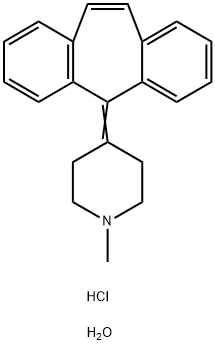Cyproheptadine hydrochloride sesquihydrate
Synonym(s):4-(5H-Dibenzo[a,d]cyclohepten-5-ylidene)-1-methyl-piperidine hydrochloride hydrate;Cyproheptadine hydrochloride sesquihydrate;Piperidine, 4-(5H-dibenzo[a,d]cyclohepten-5-ylidene)-1-methyl-, hydrochloride, hydrate (2:3)
- CAS NO.:41354-29-4
- Empirical Formula: C21H24ClNO
- Molecular Weight: 341.88
- MDL number: MFCD27967225
- EINECS: 623-762-1
- SAFETY DATA SHEET (SDS)
- Update Date: 2025-01-27 09:38:02

What is Cyproheptadine hydrochloride sesquihydrate?
Chemical properties
White or slightly yellow, crystalline powder.
The Uses of Cyproheptadine hydrochloride sesquihydrate
Cyproheptadine hydrochloride sesquihydrate has been used in:
- testing anti-inflammatory activity in serotonin receptor (5-HT) induced inflammation
- the inhibition of 5-HT in in vivo and in vitro bioassays in crabs
- the inhibition of 5-HT in embryo physiological experiments
inhibition of calcitonin gene related peptide (CGRP)
The Uses of Cyproheptadine hydrochloride sesquihydrate
H1-antihistamine, antipruritic
The Uses of Cyproheptadine hydrochloride sesquihydrate
Cyproheptadine is a first-generation antihistamine with additional anticholinergic, antiserotonergic, and local anesthetic properties. Cyproheptadine is a 5-HT2/5-HT1C serotonin receptor antagonist; H 1 histamine receptor antagonist; antipruritic.
The Uses of Cyproheptadine hydrochloride sesquihydrate
Structural studies of an antihistimine
Definition
ChEBI: The sesquihydrate of cyproheptadine hydrochloride. Note that the drug named cyproheptadine hydrochloride generally refers to cyproheptadine hydrochloride sesquihydrate. A sedating antihistamine with antimuscarinic and calcium-channel blocking actions, it i used for the relief of allergic conditions including rhinitis, conjunctivitis due to inhalant allergens and foods, urticaria and angioedema, and in pruritic skin disorders. Unlike other antihistamines, it is also a seratonin receptor antagonist, making it useful in conditions such as vascular headache and anorexia.
brand name
Periactin (Merck).
General Description
Cyproheptadine hydrochloride sesquihydrate is an antihistamine and is an antagonist of serotonin and histamine. It induced preventive effect against the development of pergolide-induced valvulopathy in a rat model.
Biochem/physiol Actions
Cyproheptadine hydrochloride sesquihydrate is a serotonin receptor (5-HT2/5-HT1C) antagonist, H1 histamine receptor antagonist and an antipruritic. The inhibition of 5-HT by cyproheptadine improves cognitive function in schizophrenia disorder. Cyproheptadine is effective for treating functional gastrointestinal disorders (FGIDs). Food and Drug Administration (FDA) approved cyproheptadine, has antidepressant and antiplatelet functionality. It may be effective in treating thromboembolic disorders. Cyproheptadine inhibits lysine methyltransferase 7/9 (Set7/9) leading to a decrease in estrogen receptor (ERα) expression and growth arrest in breast cancer cells.
Veterinary Drugs and Treatments
Cyproheptadine may be useful in cats as an appetite stimulant. It potentially
may be of benefit in the treatment of feline asthma or pruritus
in cats, but clinical experience is marginal for this indication.
Cyproheptadine is an antihistamine but its efficacy is questionable
for this indication in dogs. The drug may be useful as adjunctive
therapy for Cushing’s syndrome probably as result of its antiserotonin
activity, however one study demonstrated efficacy in less than 10% of
dogs treated for pituitary dependent hyperadrenocorticism.
Cyproheptadine may be useful as adjunctive treatment in dogs or
cats with serotonin syndrome.
In horses, cyproheptadine has been used for treating photic
head shaking and pars intermedia dysfunction (Equine Cushing’s
Disease).
Properties of Cyproheptadine hydrochloride sesquihydrate
| Melting point: | 165 °C (dec.)(lit.) |
| storage temp. | Inert atmosphere,Room Temperature |
| solubility | ethanol: soluble |
| form | solid |
| color | white to slightly yellow |
| λmax | 285nm(0.05mol/L H2SO4)(lit.) |
| Merck | 14,2773 |
| CAS DataBase Reference | 41354-29-4(CAS DataBase Reference) |
Safety information for Cyproheptadine hydrochloride sesquihydrate
| Signal word | Warning |
| Pictogram(s) |
 Exclamation Mark Irritant GHS07 |
| GHS Hazard Statements |
H302:Acute toxicity,oral H315:Skin corrosion/irritation H319:Serious eye damage/eye irritation H335:Specific target organ toxicity, single exposure;Respiratory tract irritation |
| Precautionary Statement Codes |
P261:Avoid breathing dust/fume/gas/mist/vapours/spray. P264:Wash hands thoroughly after handling. P264:Wash skin thouroughly after handling. P270:Do not eat, drink or smoke when using this product. P301+P312:IF SWALLOWED: call a POISON CENTER or doctor/physician IF you feel unwell. P302+P352:IF ON SKIN: wash with plenty of soap and water. P305+P351+P338:IF IN EYES: Rinse cautiously with water for several minutes. Remove contact lenses, if present and easy to do. Continuerinsing. |
Computed Descriptors for Cyproheptadine hydrochloride sesquihydrate
Cyproheptadine hydrochloride sesquihydrate manufacturer
Bazayan & Co.
New Products
4-Piperidinemethanol Ethyl 2,4-Dihydroxy-6-methylnicotinate Ethyl isonicotinate 3-pyridine methanol N-Methyl 4-chloro-pyridine-2-carboxamide 2-Fluoro-6-iodobenzoic acid 2-((2,6-difluorobenzyl)(ethoxycarbonyl)amino)-4-((dimethylamino)methyl)-5-(4-nitrophenyl)thiophene-3-carboxylic acid Ethyl2-oxo-2,3,9,10-tetrahydro-1H-pyrido[3',4':4,5]pyrrolo[1,2,3-de]quinoxaline-8(7H)-carboxylate Elinzanetant tert-butyl 2-(4-amino-6-chloropyrimidin-5-yloxy)ethylmethylcarbamate Phenylazomalononitrile 5,6 Dimethoxy-1-indanone 3-Iodophenylacetic acid 2-Hexyn-1-ol Dibenzo-18-crown-6 2-Propanamine, 1-chloro-, hydrochloride (9CI) 3-Pyridineacetonitrile, α-hydroxy- 3-(hexyloxy)-4-(pyridin-3-yl)-1,2,5-thiadiazole N Ethylmethylamine Ethyl Methanesulfonate N N' DimethylEthylenediamine Lead II Bromide Variamine Blue B Diazonium salt N N N'Trimethyl ethylenediamineRelated products of tetrahydrofuran








You may like
-
 41354-29-4 Cyproheptadine hydrochloride sesquihydrate 98%View Details
41354-29-4 Cyproheptadine hydrochloride sesquihydrate 98%View Details
41354-29-4 -
 41354-29-4 98%View Details
41354-29-4 98%View Details
41354-29-4 -
 Cyproheptadine Hydrochloride Sesquihydrate CAS 41354-29-4View Details
Cyproheptadine Hydrochloride Sesquihydrate CAS 41354-29-4View Details
41354-29-4 -
 Cyproheptadine hydrochloride sesquihydrate 95% CAS 41354-29-4View Details
Cyproheptadine hydrochloride sesquihydrate 95% CAS 41354-29-4View Details
41354-29-4 -
 Cyproheptadine hydrochloride CAS 41354-29-4View Details
Cyproheptadine hydrochloride CAS 41354-29-4View Details
41354-29-4 -
 5162-90-3 2-Amino-3-(1,2-dihydro-2-oxoquinoline-4-yl)propanoic acid 97%View Details
5162-90-3 2-Amino-3-(1,2-dihydro-2-oxoquinoline-4-yl)propanoic acid 97%View Details
5162-90-3 -
 4-(4-Chlorobenzyl)-2-(1-methylazepan-4-yl)phthalazin-1(2H)-one hydrochloride 98 %View Details
4-(4-Chlorobenzyl)-2-(1-methylazepan-4-yl)phthalazin-1(2H)-one hydrochloride 98 %View Details
79307-93-0 -
 (R)-2-amino-N-benzyl-3-methoxypropanamide 98%View Details
(R)-2-amino-N-benzyl-3-methoxypropanamide 98%View Details
196601-69-1
